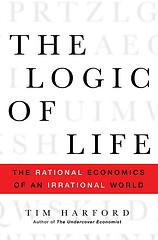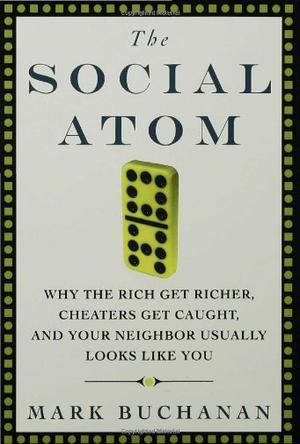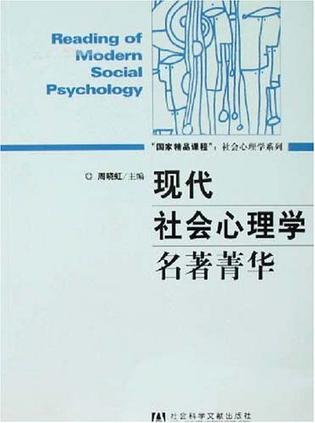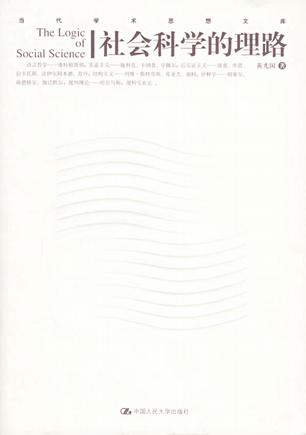欢迎来到相识电子书!
标签:社会学
-
数码人类学
人类学有两大任务,一是理解什么是人,二是理解人性是如何透过多元的文化表现出来。数码科技的蓬勃发展给这两者都带来了新的作用力。《数码人类学》向读者展示了人类与数码科技如何辩证地相互定义。最终我们试图得出一个结论,那便是“数码科技对人类到底意味着什么?” 从社交网站到数字化博物馆;从数字时代政治学到电子商务,浸润式的数码科技,给普通人的生活带来了根本性的改变。仅仅用数据来说明与理解问题显然过于太苍白,我们需要长期的定性研究,来分析人们是如何使用数码科技,而这样的行为又如何对其使用者产生影响,以及在世界范围内数码科技又是如何得到广泛运用与开发的。 《数码人类学》收录了数码文化研究领域杰出的人类学学者的前沿研究成果,向读者展示了如何运用人类学研究方法来有效地理解数码文化。《数码人类学》可用作人类学、传播学、社会学等学科以及文化研究、媒体研究等相关专业的高等教育教材。 -
非零和时代
《非零和时代》是近年来最为热议的书籍之一。 美国著名思想家、前总统克林顿智囊罗伯特•赖特继《道德动物》后,又一创新力作! 本书将生物进化和人类的文化演进进行比较,从细菌的化石一路叙述到石器时代的石斧,从中世纪伊斯兰教的商业模式一路叙述到世界贸易组织,探寻不同文化共有的发展轨迹和模式,生物演进导致人类的产生、人类组织的演进导致了文化的产生、文化的演进使地球形成一个统一的大脑。 运用博弈论的观点,揭示人类历史的必然命运:世界和人类发展的推动力和最终趋向并不是你死我活的竞争关系,而是互利共赢的合作关系,即“非零和”,进而为全球化发展指明了方向。 -
群体冲突的逻辑
个体缘何参与集体行动?群体间暴力冲突的根源何在?本书扼守理性选择理论之立场,揆诸历史上及当代的各种重大的群体冲突现象,解析认同动员与群体冲突的形成机制。与那些把群体冲突视为非理性的,将其归咎于原生文化的观点不同,作者深入地考究了塑造冲突行为的互动结构、权力格式与社会规范,揭示出自我利益在群体行动中的作用。在此基础上,作者从规范上反思了当代的社群主义政治理论,启发社会与政治制度设计的选择取向。 -
福柯-牛津通识读本
《福柯》由美国圣母大学哲学教授加里•古廷撰写,在很小的篇幅内对福柯作出了精彩的解说,为这位深奥的哲学家那复杂丰富的思想提供了导航。清华大学教授、福柯研究学者刘北成作序推荐。 从美学到惩罚体系,从疯癫与文明到尼采与先锋思想,福柯的作品对20世纪晚期的现代思想影响深远。然而,在涉及面广与影响力强的同时,这些作品也以晦涩难读著称。本书为福柯的作品提供了可信的导读,这些作品涉及文学、政治、历史、哲学等广泛领域;同时,作者加里•古廷还探究了一些关键主题,这些主题在福柯深入研究身份、知识、现代社会中的权力等领域时,曾让他甚为着迷。 -
同性爱
国内第一部全面讨论同性恋问题的学术著作,通过对历史发展规律的分析,阐释了人类史的发展是朝着同性恋者与异性恋者拥有平等权力的方向进步的。 -
宗教社会学
宗教社会学,ISBN:9787208042919,作者:(德)格奥尔格·西美尔著;曹卫东译 -
群体动力学
《群体动力学/我知道什么》是由商务印书馆出版,梅松纳夫编著的一本书籍,主要内容有群体动力学的主要研究课题,内聚力问题;遵守习俗和越轨等,可供广大读者欣赏。 -
中国人行动的逻辑
本书成书于2001年3月,2001年10月第二次印刷,深受读者的喜爱,是此领域的重要书籍。本书主要是以社会学、社会心理学和文化人类学等学科为基础,从本土化的视角,对中国人心理以及所处的中国社会与文化脉络,进行了方法论的、概念的以及经验和理论的探讨。 -
瓦尔登湖第二
《瓦尔登第二》(Walden Two)是美国著名心理学家斯金纳(B. F. Skinner)发表于1948年的一部乌托邦式小说,它以梭罗(H. D. Thoreau)的名著《瓦尔登湖》为灵感,以行为主义心理学(behavioral psychology)为基础,描述了一个虚构的小社会(small community)的生活。这个小社会像梭罗笔下的瓦尔登乌托邦一样,也是一个自治的、自足的社会,但是两者之间的一个重要区别是,斯金纳采用了实验对照(experimental control)方法塑造他的瓦尔登第二。 瓦尔登第二的居民是幸福的,因为他们拥有丰富多彩的社会关系(social relationships)和家庭生活,能尽情创造美术、音乐和文学作品,能尽情享受游戏和休憩。瓦尔登第二是自治的(self-governed)小社会,其成员同意服从一套自控技术法规(code of self-control techniques),该法规保障了居民以最低程度的紧张为代价,过上一种富于创造性的、多产的幸福生活。同时,瓦尔登第二设有若干名顾问(counselors),辅助居民的自治,他们督导居民的行为,随时帮助居民解决在执行上述法规时遇到的问题。 瓦尔登第二立有一部宪法,但是,只要瓦尔登第二的全体设计者(Planners)和三分之二管理者(Managers)投票赞成,宪法便可修改。宪法规定设立一个“设计委员会”(Board of Planners),由三男三女组成,作为瓦尔登第二的唯一政府。之所以叫做“设计委员会”,是因为最初瓦尔登第二仅仅是一纸设计方案。委员的职责是保证小社会的成功。他们制定政策,视察管理者的工作,关注全社会的总体运行情况,同时具有一定的司法职能。每一位委员任期最多十年,委员若有缺额,则由管理者提出两个候选人,供委员会选择。 管理者是专家,负责瓦尔登第二各个部门的工作和服务。书中没有明确指出管理者是怎样产生的,但是由于设计委员会是唯一权威,所以很可能是他们任命的。除了设计者和管理者,瓦尔登第二还有两种角色:工人和科学家。科学家开展实验,实验项目包括动植物的育种,婴儿行为的控制管理,等等。 在理论上和实践上,梭罗的瓦尔登和斯金纳的瓦尔登第二有很大区别。前者提倡以个人为单位的自治,后者提倡以整个共同体为单位的自治。斯金纳的言外之意是:在塑造人的行为时,个人自由意志的影响不如环境的影响那么强大。 《瓦尔登第二》发表后引起很大反响,不仅有很多评论,而且几十年来有不少人在现实中模拟创造这样的社会,例如1955年在美国康涅狄格州纽黑文,等等。 -
日常接触
符号互动学派是社会学从欧洲移植到美国后,在美国土壤上产生的一个学派,它起源于意识流创始人詹姆士把自我分成主我与客我,而后在芝加哥大学经库利发展成“镜中我”与托马斯的“情景定义”,后经米德与布鲁默进一步系统化,戈夫曼正是在这个基础上,对先前的那些大师们的理论作了进一步的检验、补充并加以精细化,提出了自己在社会学方面的戏剧表演理论,用戏剧学的理论和概念解释日常生活,把符号互动论往前推进了一大步,并对社会学的各个领域产生了不容忽视的影响。 正如美国一些评论家所说的,戈夫曼的著作对于人类的自身理解有显著的贡献,它精细地论述了社会情境中的人类行为以及我们在他人面前如何表现自己这一主题,《日常接触》一书也不例外。戈夫曼的人类行为者模式假设说,问一个男人或一个女人“真正”是什么这是毫无意义的,因为我们经常在表演。我们永远在舞台上,即使我们相信自己是最本能和最真诚地对他人进行反应时也是如此。这种假设是戈夫曼理论的出发点。 -
The Logic of Life
http://www.timharford.com/logicoflife/ “Life often seems to defy logic. When a prostitute agrees to unprotected sex, or a teenage criminal embarks on a burglary, or a smoker lights another cigarette, we seem to be a million miles from what we would call rational behaviour. None of this makes sense – or does it? Tim Harford thinks it does. And by weaving stories from locations as diverse as a Las Vegas casino and a Soho speed-date together with insights from an ingenious new breed of economist, he aims to persuade you that we are all, in fact, surprisingly logical. Reading this book, you’ll discover that the unlikeliest of people – racists, drug addicts, revolutionaries and rats – comply with economic logic, always taking account of future costs and benefits, even if they don’t quite realise it. It even explains why your boss is overpaid…” -
The Social Atom
The idiosyncrasies of human decision-making have confounded economists and social theorists for years. If each person makes choices for personal (and often irrational) reasons, how can people's choices be predicted by a single theory? How can "any" economic, social, or political theory be valid? The truth is, none of them really are. Mark Buchanan makes the fascinating argument that the science of physics is beginning to provide a new picture of the human or "social atom," and help us understand the surprising, and often predictable, patterns that emerge when they get together. Look at patterns, not people, Buchanan argues, and rules emerge that can explain how movements form, how interest groups operate, and even why ethnic hatred persists. Using similar observations, social physicists can predict whether neighborhoods will integrate, whether stock markets will crash, and whether crime waves will continue or abate. Brimming with mind games and provocative experiments, "The Social Atom" is an incisive, accessible, and comprehensive argument for a whole new way to look at human social behavior. Mark Buchanan is a theoretical physicist and an associate editor at "Complexus," a journal on biocomplexity. He has been an editor at "Nature" and "New Scientist," and is the author of two prize-nominated books, "Ubiquity: The Science of History" and "Nexus: Small Worlds and the Groundbreaking Science of Networks." He lives in Cambridgeshire, England. The idiosyncrasies of human decision-making have confounded economists and social theorists for years. If each person makes choices for personal (and often irrational) reasons, how can people's choices be predicted by a single theory? The validity of any economic, social, or political theory comes into question. Mark Buchanan argues that the science of physics is beginning to provide a new picture of the human or "social atom," and help us understand the surprising, and often predictable, patterns that emerge when they get together. Look at patterns, not people, Buchanan argues, and rules emerge that can explain how movements form, how interest groups operate, and even why ethnic hatred persists. Using similar observations, social physicists can predict whether neighborhoods will integrate, whether stock markets will crash, and whether crime waves will continue or abate. "The Social Atom" is an incisive, accessible, and comprehensive argument for a new way to look at human social behavior. "Mark Buchanan is] a theoretical physicist . . . Buchanan argues that one of the basic assumptions of economics--namely, that humans make only reasoned, greedy, self-promoting decisions--is a simplification that calls the whole field into question . . . A former editor of the prestigious science journal "Nature," Buchanan witnessed a growing number of physicists write papers about familiar mathematical patterns cropping up in human behavior. This inspired him to write "The Social Atom." His goal is to consider people 'as if they were atoms or molecules following fairly simple rules' and investigate the idea that 'seemingly complicated social happenings may often have quite simple origins, and that we can discover such simplicity by examining how we too may be subject to laws not unlike those of physics' . . . The book asks] readers to move away from thinking of humans as individuals when it comes to social behavior in a group. We are . . . simple atoms that think alike, copy one another and self-organize according to common mathematical patterns."--Russ Juskalian, "USA Today" "Humans mimic other humans, whether they're clapping or buying mobile phones, writes Mark Buchanan in his beguiling behavioral study . . . Yet the same force may influence bigger decisions in life, like whether to have kids, he says. European birthrates slowed so dramatically between 1950 and 2000 that researchers concluded the trend was 'amplified and exaggerated by peer pressure' . . . A theoretical physicist, Buchanan suggests that sociologists should spend less time scrutinizing individual behavior and more time studying the group. 'Think of patterns, not people, ' he urges, arguing that people are the atoms, or building blocks, of the social world. We imitate each other, cooperate, learn and adapt in a giant feedback system. Writing in lean, fluid sentences, Buchanan clicks through examples ranging from the collapse of Long-Term Capital Management to the slaughter at Srebrenica. He shows patterns at work in phantom traffic jams, stock sell-offs and the trails human feet carve through public parks . . . As promised in the book's subtitle, Buchanan explains 'Why the Rich Get Richer, Cheaters Get Caught, and Your Neighbor Usually Looks Like You' . . . Buchanan is] on to something big."--James Pressley, "Bloomberg News" "Likely the "Blink" or "Freakonomics "of 2007, theoretical physicist Buchanan's new book explains how we replicate the behavior of people we admire, and stick close to people with shared fundamental bonds such as ethnic heritage.""--Time Out Chicago" "Everything we think about why we do what we do is wrong because we can't help but think and act like individuals, understanding the world around us with anecdote and simple stories. But as Mark Buchanan brilliantly demonstrates with examples from the world all around us, there's a bigger force at work that explains the world far better. Surprisingly, that force looks a lot like the semi-random statistical model that explained the mysteries of quantum physics a century ago. This is a fascinating glimpse into a new way of understanding human behavior."--Chris Anderson, Editor-in-Chief, "Wired Magazine," and author of "The Long Tail: Why The Future of Business Is Selling Less of More""" "Seldom has a book so infuriated me yet kept me tightly gripped to each page. This is a first-class attack on the smugness of the Humanities by a brilliant provocateur: a disturbing challenge to all of us who think we understan -
现代社会心理学名著菁华
从纵向的历时态角度说,有关社会心理学的研究经历了社会哲学、社会经验论和社会分析学等不同阶段;而从横向的共时态角度说,社会学、心理学和人类学的路径则为们了解人性和社会行为提供了不同的研究视角。这部菁华或者说读本,从现代社会心理学的100年历史中选择出40余名篇巨制.与其说是一杯叙述人类行为的五色斑斓的鸡尾酒,不如说更像是一道剖析人类本性的精美大餐。我们承认.现代社会心理学家殚精竭虑的结果,尚没有超出孔老夫子”性相近.习相远”的睿智断言;但我们也看到他们的研究为我们提供了远为丰富的有关人性和社会行为的生动细节。 -
同性恋健康干预
《同性恋健康干预》收录了国内第一门同性恋主题课程:复旦大学研究生课程《同性恋健康社会科学》自2003年秋开课以来两年多课堂演讲的全部内容,其中有白先勇先生亲自讲《孽子》,李银河教授与大家讨论《同性恋亚文化》和同性恋要不要结婚,张北川教授纵观同性爱理论与社群发育,潘绥铭教授话说中国性文化转型中的同性恋,童戈先生深谈男同性恋的文化重构,秦士德教授漫谈性爱有度,周丹律师综述同性恋与法,一位同性恋人士说自己的心里话,一位父亲谈自己的儿子,二言先生由同性恋研究讲到恐同偏见的防艾影响,杜聪先生关注男男性行为防艾健康干预,袁子能先生志愿帮助受“双重歧视”的人们,曹宁校主管技师搭建“同志”交流平台等。 -
社会科学的理路
“没有科学史的科学哲学是空洞的,没有科学哲学的科学史是盲目的。”本书作者认为:对于华人学者而言,作为今日世界学术主流的自然科学和社会科学,都是西方文化的产物。当前华人科学研究水准低落的主要原因,在于华人的科学研究工作者对于西方的科学哲学缺乏相应的理解。基于此一认识,本书以维特根斯坦的语言哲学作为起点,系统地介绍了十七位西方思想家对于实证主义、后实证主义、结构主义、诠释学、批判理论的主要贡献,希望本书所呈现的观点能够成为华人青年学者开展其学术生涯的视阈,为华人社会的科学发展奠下扎实的基础。 -
母性
女人生來就具備母性本能嗎?母親出於本能而愛護子女,是東西方文化一向崇尚的理想,甚至科學界也普遍贊同,如今卻越來越受爭議。本書以全新的視野觀察母親的行為,並探討這新的理解角度如何改變科學家對人類演化的思考。莎拉•布萊弗•赫迪教授援引人類學、史學、文學、發展心理學、動物行為 學等多方面的知識,從「生物」與「遺傳」兩個不同的層面檢視母性本能。她剔除傳統刻板印象中對女性本質隱含的偏見,從不同於以往的角度來看母親的矛盾情緒、母職與人生大志之間的關聯、母愛與性愛的關聯,以及嬰兒的需求影響等。赫迪教授也解釋兩性長久以來關係緊繃的原因,這種緊繃又如何表現在現今社會控制女性生殖抉擇的意圖上。 人類以外靈長類的殺嬰行為是作者研究女性天性的起點,三十多年來她橫跨七個國家埋首工作,就是想更深入理解人類的親職心態,這當然與她為人母親又身兼教職的親身經驗有關,而本書正是最佳的成果展現。作者從歷史與演化的觀點闡述做母親的意義,打開我們未曾察覺的眼界,必將改變我們對於人類發展及人類行為的認知。 -
我愛身分地位
每個成人的人生可說都是以兩種愛為主軸。第一種愛──對兩性之愛的追求──早已廣為流傳與記載。第二種愛──對身分地位的追求──則較為私密,而且過程充滿羞辱。然而,第二種愛的強度卻毫不遜於第一種。」 無論古今東西,身份地位如此誘人,芸芸眾生競相追逐。 在這樣孜孜以求的背後,隱藏著一種極少人能夠坦然承認的「地位焦慮」:顧慮別人如何看待自己,顧慮自己在別人眼中究竟是成功還是失敗。而依附權貴、鑽營投機、為了妝點門面而過度消費,都是典型的症狀,造成人們晚上輾轉難眠。 艾倫•狄波頓以他一貫的生花妙筆,援引思想家、藝術家及作家的觀點與行徑,帶領我們抽絲剝繭,探索地位焦慮的根源。不僅如此,為了讓我們抒解心中的焦慮,狄波頓還精心提供了一道道奇特的妙方:效法古希臘哲人和波希米亞文化人,或者看看諷刺漫畫,甚至觀賞廢墟的石塊、在櫥櫃上擺設骷髏頭……。 翻開本書,傾聽狄波頓風趣睿智的分析及忠告,讓我們免去追求身分地位之苦,享受生活的甜美與平靜。
热门标签
下载排行榜
- 1 梦的解析:最佳译本
- 2 李鸿章全传
- 3 淡定的智慧
- 4 心理操控术
- 5 哈佛口才课
- 6 俗世奇人
- 7 日瓦戈医生
- 8 笑死你的逻辑学
- 9 历史老师没教过的历史
- 10 1分钟和陌生人成为朋友




















